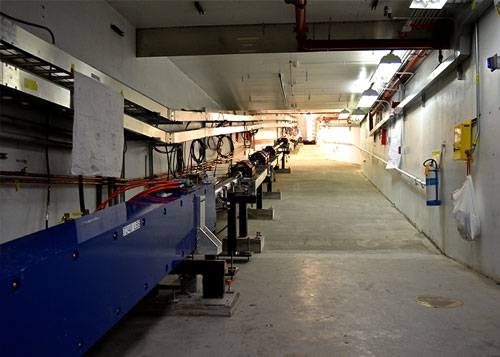CEBAF Beam Goes Over the Hump – Highest-Energy Beam Ever Delivered at Jefferson Lab

The new beamline connecting the accelerator to Hall D rises 5 meters before entering the Hall D complex.
In the early hours of May 7, the machine delivered its highest-energy beams ever, 10.5 billion electron-volts (10.5 GeV) through the entire accelerator and up to the start of the beamline for its newest experimental complex, Hall D. Then, in the last minutes of the day on May 7, the machine delivered beam, for the first time, into Hall D.
In addressing staff, Jefferson Lab Director Hugh Montgomery praised the efforts of the many Jefferson Lab staff members who made the accomplishment a reality, “It's really appreciated the way you have worked together and, in particular, the safe way in which you have pulled this off,” he said.
The CEBAF accelerator is based on superconducting radiofrequency (SRF) technology and produces a stream of charged electrons that scientists use to probe the nucleus of the atom. CEBAF was the first large-scale application of SRF technology in the U.S., and it is the world's most advanced particle accelerator for investigating the quark structure of the atom's nucleus. CEBAF was originally designed to operate at 4 GeV, and it reached 6 GeV, or 6 billion electron volts in its original configuration.
The 12 GeV Upgrade is a $338 million project to double CEBAF's maximum operational energy and includes the construction of the fourth experimental hall, as well as upgrades to equipment in the existing halls.
On May 7, 10.5 GeV beam was delivered to the Hall D Tagger Facility, which converts CEBAF's electron beam into photons that will be used for experiments in Hall D. To deliver the beam to the Tagger Facility, operators steered it through a newly installed beamline that rises 5 meters, more than 16 feet, as it approaches the Tagger Facility.
“With this accomplished, the beamline elements from the photocathode that generates the electrons through 5.5 passes of the CEBAF racetrack and the new Hall D electron beamline have gloriously transported beam!” said Arne Freyberger, Accelerator Operations manager. “This is not luck. This is a direct reflection of the quality of the staff.”
Leigh Harwood, 12 GeV Upgrade project lead for Accelerator, concurred, “The 12 GeV Upgrade project team thanks you for your dedication and the hard work that got us to this moment.”
In addition to setting a new energy record for beam in CEBAF, these significant accomplishments complete two of the major 12 GeV Project milestones necessary for Jefferson Lab to be granted the next DOE approval step, Critical Decision-4A (Accelerator Project Completion and Start of Operations).
These two accomplishments build on others. On Feb. 5, accelerator operators sent streams of electrons around the CEBAF accelerator once and achieved full upgrade-energy acceleration of 2.2 GeV in one pass. Then they ran the accelerator at this specification for the next eight hours, achieving 50 percent availability on their first run of the machine at design specifications. On April 1, the CEBAF accelerator delivered electron beams into a target in an experimental hall, recording the first data of the 12 GeV era. The machine sent electrons around the racetrack three times (known as “3-pass” beam), resulting in 6.11 GeV electrons at 2 nanoAmps average current for more than an hour. On May 3, the first beam, with energy of 6.18 GeV, was delivered to the front section of the beamline to Hall D, thus demonstrating that all 5.5 passes of the accelerator were functional and there were no obstructions in the way of the beam. With 5.5 passes functional, CEBAF energy was scaled to 10.5 GeV to achieve these last two milestones.
DOE approval of Critical Decision 4A will permit accelerator operators to continue commissioning the accelerator in order to achieve full 12 GeV energy and to send electron beams to Jefferson Lab's experimental halls for commissioning and the start of experiments.
Jefferson Science Associates, LLC, a joint venture of the Southeastern Universities Research Association, Inc. and PAE Applied Technologies, manages and operates the Thomas Jefferson National Accelerator Facility, or Jefferson Lab, for the U.S. Department of Energy's Office of Science.
DOE’s Office of Science is the single largest supporter of basic research in the physical sciences in the United States, and is working to address some of the most pressing challenges of our time. For more information, visit science.energy.gov.
Contact: Kandice Carter, Jefferson Lab Public Affairs, 757-269-7263, kcarter@jlab.org
Media Contact
All latest news from the category: Physics and Astronomy
This area deals with the fundamental laws and building blocks of nature and how they interact, the properties and the behavior of matter, and research into space and time and their structures.
innovations-report provides in-depth reports and articles on subjects such as astrophysics, laser technologies, nuclear, quantum, particle and solid-state physics, nanotechnologies, planetary research and findings (Mars, Venus) and developments related to the Hubble Telescope.
Newest articles

Superradiant atoms could push the boundaries of how precisely time can be measured
Superradiant atoms can help us measure time more precisely than ever. In a new study, researchers from the University of Copenhagen present a new method for measuring the time interval,…

Ion thermoelectric conversion devices for near room temperature
The electrode sheet of the thermoelectric device consists of ionic hydrogel, which is sandwiched between the electrodes to form, and the Prussian blue on the electrode undergoes a redox reaction…

Zap Energy achieves 37-million-degree temperatures in a compact device
New publication reports record electron temperatures for a small-scale, sheared-flow-stabilized Z-pinch fusion device. In the nine decades since humans first produced fusion reactions, only a few fusion technologies have demonstrated…





















